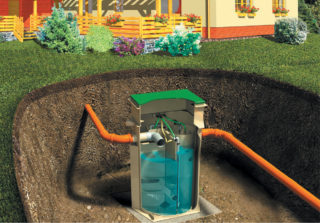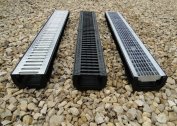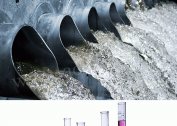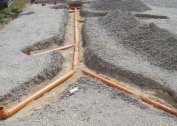Today, many city dwellers acquire suburban land plots for growing natural products, relaxing from the gray city bustle and even permanent residence in the green zone they created. But, if in the city all the benefits of civilization are provided by utilities and energy companies, then on the garden plot, the owners themselves have to take care of the energy supply, the availability of water and the disposal of waste products. And, of course, latrines are built first. And since many citizens do not want to give up urban comfort in their summer cottages, in addition to latrines, various sewer septic tanks are installed, which will be discussed in this article.
Cesspools
 The simplest and cheapest option for a septic tank in the country is a cesspool filter pit. Those. “Amenities on the street.” This septic tank is arranged as follows: an ordinary hole is dug up to a depth of 1-2 meters, its walls are strengthened with wooden formwork, or coated with clay. Sometimes metal barrels or old car tires are inserted into such a pit. A wooden structure is installed on top, which serves as a toilet. The liquid entering this pit goes to the ground, and solid particles remain and accumulate over time. The advantages of such a structure are simplicity and cheapness. Cons - such a hole must be cleaned manually at least once every 3 months. In addition, dirty water, which is absorbed into the soil, worsens, over time, the ecological cleanliness of the site.
The simplest and cheapest option for a septic tank in the country is a cesspool filter pit. Those. “Amenities on the street.” This septic tank is arranged as follows: an ordinary hole is dug up to a depth of 1-2 meters, its walls are strengthened with wooden formwork, or coated with clay. Sometimes metal barrels or old car tires are inserted into such a pit. A wooden structure is installed on top, which serves as a toilet. The liquid entering this pit goes to the ground, and solid particles remain and accumulate over time. The advantages of such a structure are simplicity and cheapness. Cons - such a hole must be cleaned manually at least once every 3 months. In addition, dirty water, which is absorbed into the soil, worsens, over time, the ecological cleanliness of the site.
Cesspool with pipe
 An improved variant of the cesspool of the filtering pit is a cesspool that is connected to the house by a sewer pipe. The walls of this pit are reinforced with concrete rings (without sealing joints) or brickwork (with gaps, for better water penetration into the soil), the bottom also does not close with anything. But the depth of such a pit should be no more than 3 m, otherwise there is a risk of infecting groundwater. From above, such a container is covered with a concrete or metal lid with openings for the ventilation pipe (it is better to make it taller than human height, then the smell of sewage will be much less noticeable) and for the manhole cover, through which it will be possible to pump out sewage with sewage equipment. The advantages of this design is that it is more comfortable (the toilet is in the house and the sink has a drain into the sewer), it is cleaned less often than “amenities on the street” and not manually. Cons - all the same violation of the ecology of the garden plot and unpleasant odors on the plot, characteristic of sewage.
An improved variant of the cesspool of the filtering pit is a cesspool that is connected to the house by a sewer pipe. The walls of this pit are reinforced with concrete rings (without sealing joints) or brickwork (with gaps, for better water penetration into the soil), the bottom also does not close with anything. But the depth of such a pit should be no more than 3 m, otherwise there is a risk of infecting groundwater. From above, such a container is covered with a concrete or metal lid with openings for the ventilation pipe (it is better to make it taller than human height, then the smell of sewage will be much less noticeable) and for the manhole cover, through which it will be possible to pump out sewage with sewage equipment. The advantages of this design is that it is more comfortable (the toilet is in the house and the sink has a drain into the sewer), it is cleaned less often than “amenities on the street” and not manually. Cons - all the same violation of the ecology of the garden plot and unpleasant odors on the plot, characteristic of sewage.
Sealed pit
 Sealed cesspool - a device that makes the cesspool even more perfect. The name speaks for itself. This means that a sealed container made of concrete rings with a concrete bottom and sealed joints, or a plastic tank, which also connects to the living room with a sewer pipe, is buried in the ground. Only this system no longer lets sewage into the ground. This means that there is no risk to infect the soil and groundwater. Such a container closes with a sealed cap into which a ventilation pipe is inserted to remove unpleasant odors. Sewage is pumped out of such a tank by sewage equipment.
Sealed cesspool - a device that makes the cesspool even more perfect. The name speaks for itself. This means that a sealed container made of concrete rings with a concrete bottom and sealed joints, or a plastic tank, which also connects to the living room with a sewer pipe, is buried in the ground. Only this system no longer lets sewage into the ground. This means that there is no risk to infect the soil and groundwater. Such a container closes with a sealed cap into which a ventilation pipe is inserted to remove unpleasant odors. Sewage is pumped out of such a tank by sewage equipment.
Advantages of such a system:
- sanitary safety and the lack of the possibility of infection of the environment with harmful bacteria;
- the installation of a sealed cesspool does not depend on the depth of groundwater and on the type of soil on the site;
- the absence of an unpleasant odor in the area (although if the drive is made in the form of a well, then the smell is possible).
Minuses:
- the cost of the tank itself and its installation is much higher than other types of cesspools;
- regular expenses for sewage equipment.
Septic tanks with soil treatment
 Another type of septic tanks installed in summer cottages is a system with soil post-treatment of sewage. Sewerage cleaning in such septic tanks is carried out due to the oxygen-free decomposition of harmful substances by anaerobic microorganisms, followed by filtering the treated water with sand or sandy soils. Such a structure consists of three or four tanks, each of which performs its own cleaning function. The first tank is sealed and designed for rough cleaning of sewage, the heaviest substances are deposited here. Lighter particles are poured into the second, and then into the third container (if provided). They are also airtight. In each tank, the sewage fluid undergoes anaerobic treatment, in which special bio-additives decompose harmful substances. These bioactivators are commercially available (for example, Dr. Robik or Biocept). In order to add such a drug to the tank, you do not need to open it, it is enough to rinse a portion of this substance twice a month in the toilet. These tanks are made of concrete, brick, plastic or metal containers connected by sewer pipes. Ready-made cleaning systems with integrated tanks, such as Tank, are also sold.
Another type of septic tanks installed in summer cottages is a system with soil post-treatment of sewage. Sewerage cleaning in such septic tanks is carried out due to the oxygen-free decomposition of harmful substances by anaerobic microorganisms, followed by filtering the treated water with sand or sandy soils. Such a structure consists of three or four tanks, each of which performs its own cleaning function. The first tank is sealed and designed for rough cleaning of sewage, the heaviest substances are deposited here. Lighter particles are poured into the second, and then into the third container (if provided). They are also airtight. In each tank, the sewage fluid undergoes anaerobic treatment, in which special bio-additives decompose harmful substances. These bioactivators are commercially available (for example, Dr. Robik or Biocept). In order to add such a drug to the tank, you do not need to open it, it is enough to rinse a portion of this substance twice a month in the toilet. These tanks are made of concrete, brick, plastic or metal containers connected by sewer pipes. Ready-made cleaning systems with integrated tanks, such as Tank, are also sold.
After the sewage fluid passes through all the tanks with anaerobic biological treatment, the final stage of purification follows - overflow in most of the purified water to the filtration field, to the filter well or other soil treatment plant. As already mentioned, the filter in the drainage field should consist of sandy or sandy soils that are well permeable to water, otherwise the water will be poorly drained and cleaned.
Advantages of the system with soil post-treatment:
- septic tanks are cleaned with wastewater treatment equipment quite rarely - once every 1-2 years with a permanent residence of three people;
- high efficiency of water purification (95-98%);
- ease of maintenance and non-volatility.
Minuses:
- constant purchase of bioactivators;
- a rather high cost of installation and installation (from 30 to 70 thousand rubles);
- at a high groundwater level or on clay soil, such systems cannot be built, since soil filtration is ineffective under these conditions.
Septic tanks with biological treatment
 Septic tanks with deep biological treatment are installed in any soil and regardless of the groundwater level, i.e. in any conditions. These systems do not need to be designed by yourself - they are manufactured in an industrial environment and sold ready-made. It remains only to connect such a device to the sewer. The principle of cleaning sewage with a biological treatment system is identical to the operation of a septic tank with soil post-treatment: as well, wastewater overflows from one chamber to another, passing several stages of treatment. Only in this case there is no liquid purification by soil, but there is a more thorough decomposition of harmful substances using aerobic bacteria - in the first chamber, the sewage liquid is divided into heavy (insoluble) sediments that remain at the bottom and lighter ones that overflow into the next tank and are exposed there processing anaerobic and aerobic bacteria. But in order for these bacteria to effectively decompose harmful substances, special devices are connected to the system - aerators, which saturate the medium in the tank with air.
Septic tanks with deep biological treatment are installed in any soil and regardless of the groundwater level, i.e. in any conditions. These systems do not need to be designed by yourself - they are manufactured in an industrial environment and sold ready-made. It remains only to connect such a device to the sewer. The principle of cleaning sewage with a biological treatment system is identical to the operation of a septic tank with soil post-treatment: as well, wastewater overflows from one chamber to another, passing several stages of treatment. Only in this case there is no liquid purification by soil, but there is a more thorough decomposition of harmful substances using aerobic bacteria - in the first chamber, the sewage liquid is divided into heavy (insoluble) sediments that remain at the bottom and lighter ones that overflow into the next tank and are exposed there processing anaerobic and aerobic bacteria. But in order for these bacteria to effectively decompose harmful substances, special devices are connected to the system - aerators, which saturate the medium in the tank with air.
In the third chamber, the process of settling the liquid purified in the first two tanks takes place.It is divided into heavy suspensions, which sink to the bottom and form a precipitate in the form of activated sludge, used as an excellent organic fertilizer and into clean water, which is discharged from this tank through a pipe located much higher than the level of sludge. Such water is of technical quality and can be used for household needs (for example, for irrigation of a site) or, without harm to the environment, be discharged into any body of water or soil.
At a price, a biological treatment system is more expensive than a septic tank with soil post-treatment. But, if we take into account the cost of installing individual tanks and creating a filtration field in the soil post-treatment system, the absence of these works in the installation of a biological treatment plant equalizes the cost of these systems.
Advantages of septic tanks of deep biological treatment:
- high level of sewage treatment (up to 99%);
- complete absence of unpleasant odors;
- simple and quick installation - the biological treatment plant is sold ready to use. It remains only to dig a pit under it and attach it to the sewer pipe. It takes 1-2 days, not more;
- This septic tank does not require constant care, it works on its own, and the solid sediment accumulates very slowly, so the tanks are cleaned every 5-8 years.
The disadvantage of this system is its complete energy dependence. Without electricity or in areas with an unstable supply of electricity, a deep biological treatment plant is useless.
Comfort in the country is a relative concept. If you visit your land only in the summer season, and then only on weekends, then talking about expensive septic tanks and comfortable plumbing makes no sense, it will be a waste of money. But if you are going to live in the country all the time, then “amenities on the street” after urban comfort are quite unnerving. I want to make my place of residence comfortable and civilized. But it takes money. As they say, think for yourself, decide for yourself whether to have or not to have.


